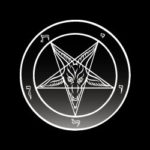
Church of Satan History: Media Circus
Once the Church of Satan started getting international press, local reports tapered off. While the San Francisco media enjoyed writing about Anton when he was a local eccentric—ghost-hunter, sorcerer, and keeper of lions and leopards as household pets—he was no longer fun when he became an internationally-recognized Satanist. People were beginning to take Satanism seriously. Magazine articles on cults and covens imitating the Church of Satan were suddenly springing up from New York to London. By the time The Satanic Bible was released in 1969, membership in the Church of Satan had already grown to well over 10,000 worldwide.
Articles constantly appeared in newspapers around the world as editors sent their reporters to find out why everyone was buzzing about this San Francisco sorcerer. LaVey and the Church of Satan got major coverage in U.S. magazines like Cosmopolitan, Time, Newsweek, Seventeen, even appearing on the cover of Look. Wax figures of LaVey were exhibited in a dozen museums in various parts of the world, the original cast at Madame Tussaud’s wax works in London. The first authentic Black Mass ever recorded, pre-dating the “Black Metal” bands by a couple of decades, was taped live at the Church of Satan in 1968, even before The Satanic Bible was published. Among LaVey’s flurry of radio and television appearances from 1967 to 1974, one particularly memorable performance was an elaborate on-camera ritual for Johnny Carson’s 7th Anniversary show, summoning success for the upcoming year.
Among the first articles written about the new High Priest of Satan was Shana Alexander’s “The Feminine Eye” column in February, 1967, then running in Life magazine. Titled “The Ping is The Thing,” the article opens by describing a ping that is often heard when idly listening to the morning news broadcast: “This ping seems to signal that something funny, or weird, or maybe even profound may have just occurred, although one is never sure.” Alexander then goes on to give a wonderfully engaging account of LaVey and his activities in those early days, describing, as she says, “the jarring clash between the exotic and the utterly banal.”
The Second Coming, released in 1970, had been the established text on Satanism until its author, Arthur Lyons, wrote another book in 1988, Satan Wants You, which updates his first, providing fresh material on Anton LaVey and dispelling much of the claims of Satanic animal sacrifices and “ritual abuse” of children. Lyons’ evocative reporting and appreciation of the metaphorical aspects of Satanism provide a darkly enthralling vision of LaVey.
Newsweek magazine has done a few articles covering LaVey’s exploits. One from August 16, 1971, entitled “Evil, Anyone?,” was already raising questions about suspected “Satanic crimes” that have plagued LaVey from his organization’s beginnings. Anton’s answer has been consistent over the years: “Satanism,” he insists, “is developing two circles, an elitist group which I always intended my church to be, and the faddists who are becoming Satanists because it’s the thing to do.” Discovering that murder isn’t on Satanism’s list of required sacraments, diligent Newsweek reporters had to find something else to entice thrill-seeking readers: “Indeed, far from preaching sexual or political anarchy, LaVey describes his goal as the creation of a police state in which the weak are weeded out and the achievement-oriented leadership is permitted to pursue the mysteries of black magic.”
Because of LaVey’s nude female altars (more than a few fetishists addressed their letters of inquiry to “the redheaded nude altar”), there were plenty of men’s magazines willing to cover the Church of Satan, jumping at the juicy, ready-made excuse for nudie shots. LaVey himself flashed his ample equipment in certain issues of Jaybird Journal and the like. Though most of the stories accompanying the pictures were limited to recounting ancient myths of devil’s orgies and naked, nubile acolytes tied to sacrificial altars, several were written by Burton Wolfe, who eventually wrote a much-needed biography of LaVey in 1974. Wolfe joined the Church of Satan for a brief period in 1968 when, as he writes, “LaVey was still in his prankish stage. The rituals and parties in his black house were full of fun and humor, and I thoroughly enjoyed capers such as playing the role of the director of the insane asylum in the Madness of Logic rite.” Wolfe continued to fan interest in LaVey with articles up into the early 1980’s and, though he had to drop out of the Church of Satan because he felt it was evolving into a “harsh, vindictive, crypto-fascist style organization,” Wolfe wrote a comprehensive introduction to The Satanic Bible which served as the only reliable biographical reference on LaVey since The Devil’s Avenger went out of print, until the release of The Secret Life of A Satanist: the authorized biography of Anton LaVey.
While reporters had been relatively fair to the Church of Satan in the late 1960’s, LaVey saw a sharp decline in open-minded, objective reporting in the mid-1980’s. In 1984, he stated: “If real Satanism were allowed the kind of television time that Christianity has now, the kind of drawing out and patience that interviewers give sports figures, or the kind of coverage that a baseball game gets, Christianity would be completely eliminated in a few short months. If people were allowed to see the complete, unbiased truth, even for 60 minutes, it would be too dangerous. There would be no comparison.”
by Blanche Barton ©2003
(condensed from The Church of Satan and with supplemental material by Peter H. Gilmore)

Organization

Church of Satan
Founded by Anton Szandor LaVey
We Are Legion
A Moment In Time
This slideshow requires JavaScript.
SUPPORT THE
CHURCH OF SATAN!
There are many ways you can support the Church of Satan. Visit our support page to learn how.
navigation-topper


